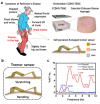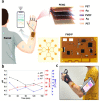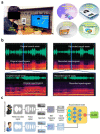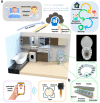Progress of Advanced Devices and Internet of Things Systems as Enabling Technologies for Smart Homes and Health Care
- PMID: 36855708
- PMCID: PMC9928409
- DOI: 10.1021/acsmaterialsau.2c00001
Progress of Advanced Devices and Internet of Things Systems as Enabling Technologies for Smart Homes and Health Care
Abstract
In the Internet of Things (IoT) era, various devices (e.g., sensors, actuators, energy harvesters, etc.) and systems have been developed toward the realization of smart homes/buildings and personal health care. These advanced devices can be categorized into ambient devices and wearable devices based on their usage scenarios, to enable motion tracking, health monitoring, daily care, home automation, fall detection, intelligent interaction, assistance, living convenience, and security in smart homes. With the rapidly increasing number of such advanced devices and IoT systems, achieving fully self-sustained and multimodal intelligent systems is becoming more and more important to realize a sustainable and all-in-one smart home platform. Hence, in this Review, we systematically present the recent progress of the development of advanced materials, fabrication techniques, devices, and systems for enabling smart home and health care applications. First, advanced polymer, fiber, and fabric materials as well as their respective fabrication techniques for large-scale manufacturing are discussed. After that, functional devices classified into ambient devices (at home ambiance such as door, floor, table, chair, bed, toilet, window, wall, etc.) and wearable devices (on body parts such as finger, wrist, arm, throat, face, back, etc.) are presented for diverse monitoring and auxiliary applications. Next, the current developments of self-sustained systems and intelligent systems are reviewed in detail, indicating two promising research directions in this field. Last, conclusions and outlook pinpointed on the existing challenges and opportunities are provided for the research community to consider.
© 2022 The Authors. Published by American Chemical Society.
Conflict of interest statement
The authors declare no competing financial interest.
Figures











































Similar articles
-
Smart Home-based IoT for Real-time and Secure Remote Health Monitoring of Triage and Priority System using Body Sensors: Multi-driven Systematic Review.J Med Syst. 2019 Jan 15;43(3):42. doi: 10.1007/s10916-019-1158-z. J Med Syst. 2019. PMID: 30648217
-
Piezoelectric Energy Harvesting towards Self-Powered Internet of Things (IoT) Sensors in Smart Cities.Sensors (Basel). 2021 Dec 13;21(24):8332. doi: 10.3390/s21248332. Sensors (Basel). 2021. PMID: 34960426 Free PMC article. Review.
-
Use of an Internet-of-Things Smart Home System for Healthy Aging in Older Adults in Residential Settings: Pilot Feasibility Study.JMIR Aging. 2020 Nov 10;3(2):e21964. doi: 10.2196/21964. JMIR Aging. 2020. PMID: 33170128 Free PMC article.
-
Smart Transportation: An Overview of Technologies and Applications.Sensors (Basel). 2023 Apr 11;23(8):3880. doi: 10.3390/s23083880. Sensors (Basel). 2023. PMID: 37112221 Free PMC article. Review.
-
Secure smart home architecture for ambient-assisted living using a multimedia Internet of Things based system in smart cities.Math Biosci Eng. 2024 Feb 5;21(3):3473-3497. doi: 10.3934/mbe.2024153. Math Biosci Eng. 2024. PMID: 38549292
Cited by
-
A near-zero energy system based on a kinetic energy harvester for smart ranch.iScience. 2022 Dec 1;25(12):105448. doi: 10.1016/j.isci.2022.105448. eCollection 2022 Dec 22. iScience. 2022. PMID: 36590459 Free PMC article.
-
Triboelectric Mat Multimodal Sensing System (TMMSS) Enhanced by Infrared Image Perception for Sleep and Emotion-Relevant Activity Monitoring.Adv Sci (Weinh). 2025 Feb;12(6):e2407888. doi: 10.1002/advs.202407888. Epub 2024 Dec 19. Adv Sci (Weinh). 2025. PMID: 39698892 Free PMC article.
-
Patient-Generated Health Data (PGHD): Understanding, Requirements, Challenges, and Existing Techniques for Data Security and Privacy.J Pers Med. 2024 Mar 3;14(3):282. doi: 10.3390/jpm14030282. J Pers Med. 2024. PMID: 38541024 Free PMC article. Review.
-
Advances and Applications of Metal-Organic Frameworks (MOFs) in Emerging Technologies: A Comprehensive Review.Glob Chall. 2023 Dec 30;8(2):2300244. doi: 10.1002/gch2.202300244. eCollection 2024 Feb. Glob Chall. 2023. PMID: 38356684 Free PMC article. Review.
-
Advanced Implantable Biomedical Devices Enabled by Triboelectric Nanogenerators.Nanomaterials (Basel). 2022 Apr 15;12(8):1366. doi: 10.3390/nano12081366. Nanomaterials (Basel). 2022. PMID: 35458075 Free PMC article. Review.
References
-
- Niu S.; Matsuhisa N.; Beker L.; Li J.; Wang S.; Wang J.; Jiang Y.; Yan X.; Yun Y.; Burnett W.; Poon A. S. Y. Y.; Tok J. B. H. B.-H.; Chen X.; Bao Z. A Wireless Body Area Sensor Network Based on Stretchable Passive Tags. Nat. Electron. 2019, 2 (8), 361–368. 10.1038/s41928-019-0286-2. - DOI
Publication types
LinkOut - more resources
Full Text Sources
